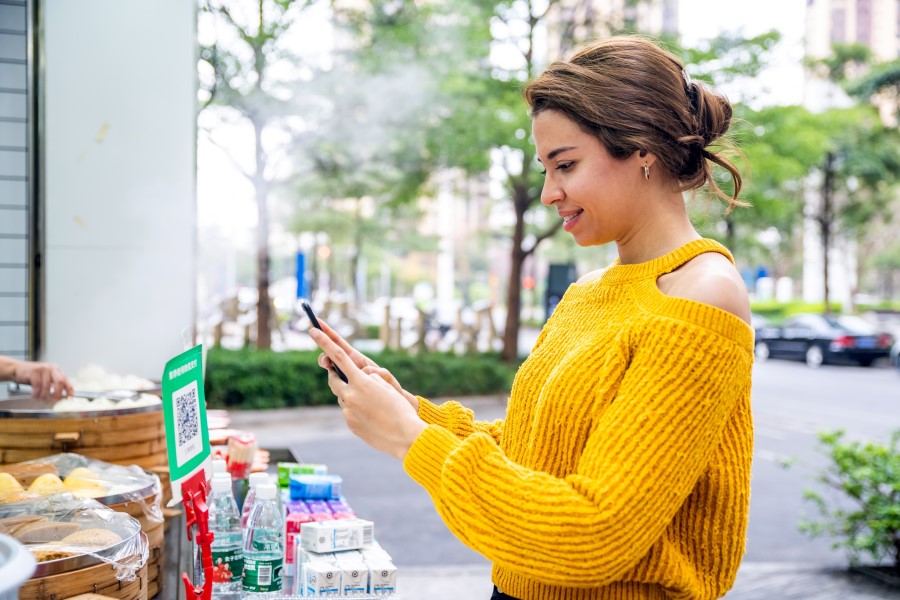
Retailers around the world are being urged to act now to meet the ‘ambition date’ of 2027 for having the capability to scan data-rich 2D barcodes at point of sale (POS).
GS1, the only authorised provider of authentic and unique barcodes, is working to ensure 2D barcodes can be scanned and processed at any retail POS system by the end of 2027.
At a recent Ai Group webinar, GS1 Australia CEO Maria Palazzolo said organisations need to have a long-term approach in their plan to transition from traditional linear 1D barcodes to the 2D variety.
“It’s a project I would urge you to take very seriously and to start working on now — at least start planning,” Ms Palazzolo said.
“Retailers need to understand 2D barcodes are coming, and we at GS1 are here to support them in their implementation journeys.
“There's no timeframe for removing traditional 1D barcodes, but in the future, the transition to 2D barcodes will be total.”
2D barcodes include QR codes powered by GS1 (GS1 QR barcodes) and the GS1 DataMatrix.
Today, GS1 DataMatrix barcodes are found on a range of therapeutic products and in some retailers, such as Woolworths, across categories like poultry and meat.
GS1 QR barcodes are not the same as the QR codes routinely scanned during the height of Covid.
“They all look the same to the human eye, but they carry very different data,” Ms Palazzolo said.
Like the traditional linear 1D barcode, GS1 QR barcodes contain a barcode number or GTIN (global trade item number) as well as a web address that acts as a key to access further product information that can’t fit on packaging.
“Because these QR codes are based on GS1 standards, anyone who scans them will be able to derive the same information as what the brand owner puts into that code,” Ms Palazzolo said.
“This is an important aspect of differentiating between a ‘normal’ QR code and one that is powered by GS1.
“The information brand owners will want to share with consumers will depend on the product category, but the framework and that level of consistency we want to be able to achieve across different industries will be the same.”
GS1 QR barcodes give brand owners direct access to consumers and can provide a ‘window’ to any type of information and data the brand owner wishes to share.
“This type of barcode offers a range of possibilities for brand owners, including in the areas of sustainability and traceability, which many CEOs struggle with,” Ms Palazzolo said.
They can also provide access to information on:
“You are limited only by your imagination as to what kind of data you can share with consumers,” Ms Palazzolo said.
“The ability for consumers to access information around the traceability of a product, as well as industry needing to have that information, is very much wanted and needed — which is why 2D barcodes become part of the solution.”
Regardless of the driver for adopting 2D barcodes, the consumer should ultimately be at the centre of conversations about how industry transitions, Ms Palazzolo says.
“We want to ensure there is a level of consistency and harmonisation in the implementation of 2D barcodes to ensure consumers know what to expect when they scan one of these codes — it’s important they know they will have a consistent experience, that they're going to be able to access the same type of information in the same types of formats.
“At the same time, we want to give brands flexibility to be able to leverage 2D barcodes for marketing and other types of promotional activities.
“Therefore, we need to make sure we find a happy medium between flexibility and consistency to ensure consumers know what to expect so they can trust the code and the data that sits behind it, so the usage of these codes increases.”
“There will be a period that we call the interim phase where we will see both barcodes together,” Ms Palazzolo said.
“That’s necessary, because not all retailers are going to be able to scan 2D barcodes initially, so the capability of scanning 1D barcodes will remain.
“There is no timeframe around this interim phase. We’re not suggesting that by 2027 the 1D barcode will suddenly disappear and the 2D barcode becomes the only barcode on the product.
“That’s the endgame we're heading towards.
“We’re focused on making this transition as painless and as beneficial as possible for every player in the supply chain.”
Many pilot projects are underway around the world, with participating organisations willing to share their learnings.
“It’s not a competitive subject,” Ms Palazzolo said.
“We want everybody to learn from each other on what is the best way to do this and the benefits that can be derived, not only from GS1 QR barcodes but the pilots, too.
“Industry needs to come together. We need to do it in a coordinated, aligned approach.
“There's no point in organisations going off and doing their own thing in a proprietorial way.”
“There’s an enormous amount of activity going on in the EU around the Digital Product Passport, with regulation taking effect in the next couple of years for particular types of products, like batteries, where complete traceability of the product is required and regulated,” Ms Palazzolo said.
“We don't have regulation here in Australia, and I suspect we're not necessarily looking for it either but, of course, if you trade with any of the countries in Europe, you will be obliged to comply to their regulations.
“So, if the 2D barcode is put on the product, it will be able to travel around the world — as long as it's powered by GS1 — and the data won’t need to be changed because the universal language of GS1 will be embedded in that QR code.”
In Australia, transition activities have largely occurred in the retail FMCG (fast-moving consumer goods) sector.
“Woolworths is a great example of a retailer working hard to leverage the power of 2D barcodes,” GS1 Australia Chief Operating Officer Marcel Sieria said.
“The journey started several years back when they started implementing the GS1 DataMatrix — a stepping stone to get them ready to implement QR codes powered by GS1.
“Woolworths will begin to roll out their capability for GS1 QR barcodes nationally next year, but the benefits they've received so far are incredible.
“From a food safety perspective, their implementation of GS1 DataMatrix barcodes has allowed them to automatically prevent the sale of expired products at point of sale.
“The ability for these codes to have batch numbers included in them also allows Woolworths to be much more targeted in executing a product recall or withdrawal.
“They've also managed to have an impact in the context of waste reduction, as retailers can automatically apply discounts as products approach their expiry date.”
From an online fulfillment perspective, the data-rich barcodes enable Woolworths staff to check the lifespan of items before they’re packed and delivered to customers.
“Woolworths has experienced massive productivity in store,” Mr Sieria said.
“They’re rolling out this capability on a category-by-product-category basis as they move towards GS1 QR barcodes. It's exciting stuff.”
GS1 is not pushing for regulation in Australia.
“We'd rather industry come together and take a responsible approach, as opposed to waiting for governments to come along and regulate,” Ms Palazzolo said.
GS1 Australia is working with other retailers, not only within the food and grocery sector, but across other product categories, too.
They are all at different stages of the transition journey.
“In some cases, they’re only beginning to look at their current capabilities, such as their scanning equipment or POS systems, to see if they can support 2D barcodes.
“Other retailers are at the business case stage where they're considering investments to make themselves capable, and some are already piloting.
“Traceability activities are adding momentum to the retailer adoption around 2D barcodes in Australia.”
It’s not just a food and grocery project.
“While we are starting the conversation in the context of food and grocery products, we want to make sure we can take this conversation into other industry sectors by working with industry peak bodies in those sectors —whether that’s alcoholic beverages, apparel products or cosmetics,” Ms Palazzolo said.
“What we've done so far is establish the project. We've got a steering committee, a reporting framework and terms of reference. Now we’re in the middle of developing the initial components of that framework, which we hope to be able to test through industry pilots later this year.”
GS1 acknowledges the transition won’t be easy for some.
“Organisational change is normally not easy,” Ms Palazzolo said.
“This is why we are urging organisations to start now; don't wait until the last minute.
“We're here to assist you through the process — we have a whole team of people ready and prepared to help.
“Companies may be feeling slightly nervous about all of this, but it should not be feared.
“It should be embraced as an enormous opportunity.”
GS1 is a global, not-for-profit organisation that has more than 2million member companies and operates in 116 markets around the world.
It is developing a range of free accessible documents and support tools for industry to navigate the implementation of 2D barcodes.
Head to GS1 Australia for further information.

Wendy Larter is Communications Manager at the Australian Industry Group. She has more than 20 years’ experience as a reporter, features writer, contributor and sub-editor for newspapers and magazines including The Courier-Mail in Brisbane and Metro, the News of the World, The Times and Elle in the UK.